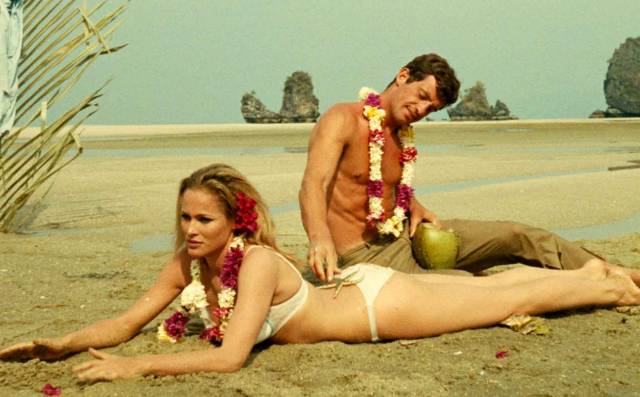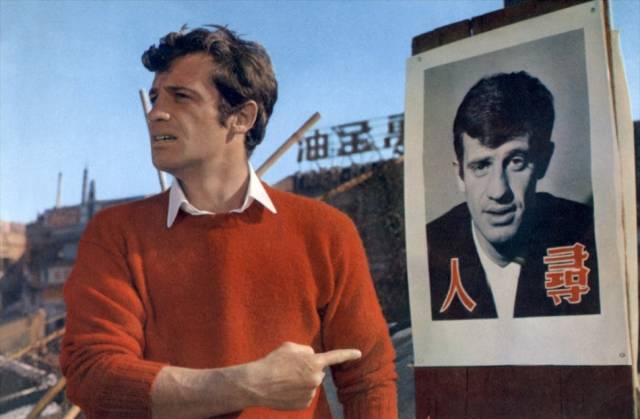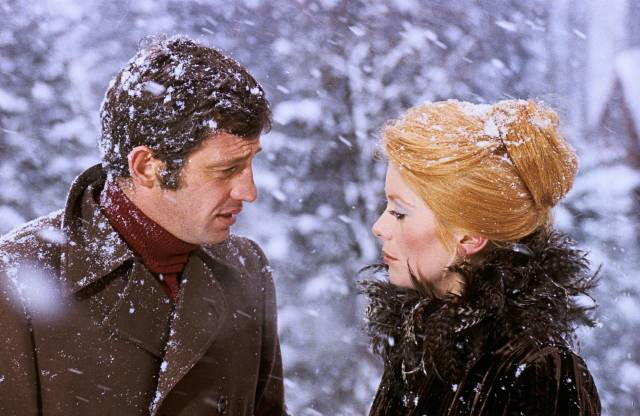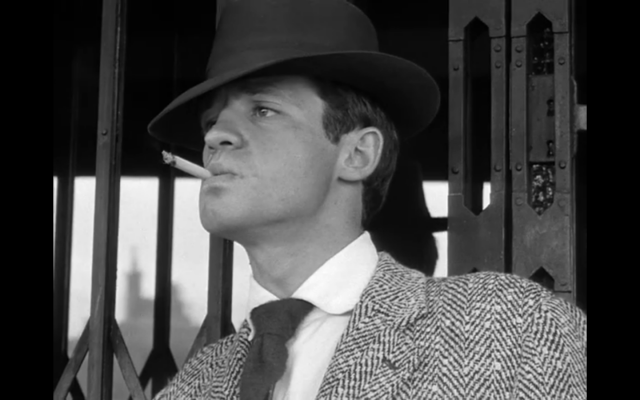
 Jean- Paul Belmondo is one of the greatest actors in history, and anyone who has seen even a handful of French films from the 1960s has likely seen him in action. His early work enthroned him as a figure central in the French New Wave movement. Early on he was commonly cast as a bad-boy, but he played all his characters as having strong emotional sides, as well as witty intellects. Since Belmondo is a true all-around performer, a real showman, playing the bad-boy was never a gimmick. He plays all his roles differently, and he is as much fun to watch for his resonating charm and comic skill as he is for his serious dramatic, multi-layered characters.
Jean- Paul Belmondo is one of the greatest actors in history, and anyone who has seen even a handful of French films from the 1960s has likely seen him in action. His early work enthroned him as a figure central in the French New Wave movement. Early on he was commonly cast as a bad-boy, but he played all his characters as having strong emotional sides, as well as witty intellects. Since Belmondo is a true all-around performer, a real showman, playing the bad-boy was never a gimmick. He plays all his roles differently, and he is as much fun to watch for his resonating charm and comic skill as he is for his serious dramatic, multi-layered characters.
To commemorate the 50th anniversary of That Man from Rio, Film Forum will show a pristine restoration of the film and to celebrate the occasion, we've compiled a list of Belmondo’s five best performances!
 5) Up To His Ears (1965) Directed by Philippe de Broca- The director's follow-up to That Man From Rio, has two very special qualities: it has arguably the prettiest “Belmondo girl,” Ursula Andress, and this is saying a considerable amount when noting that every one of these films has an insanely beautiful lead actress. But Andress stands out, although not just for her beauty, but for not being able to act. She appears here strictly because she is so gorgeous, just as she appeared in Dr. No (1962) three years earlier for the same reason. The second reason is that Belmondo's character begins the film as a depressing, pitiful chap, but when he cuts off his hipster-like bangs he suddenly becomes a raging action star! Is there a lesson to be learned here? With no discernible point or reason to be, this film is really just about enjoying the exotic scenery while watching Belmondo perform all this own stunts, a hallmark he maintained for most of his career.
5) Up To His Ears (1965) Directed by Philippe de Broca- The director's follow-up to That Man From Rio, has two very special qualities: it has arguably the prettiest “Belmondo girl,” Ursula Andress, and this is saying a considerable amount when noting that every one of these films has an insanely beautiful lead actress. But Andress stands out, although not just for her beauty, but for not being able to act. She appears here strictly because she is so gorgeous, just as she appeared in Dr. No (1962) three years earlier for the same reason. The second reason is that Belmondo's character begins the film as a depressing, pitiful chap, but when he cuts off his hipster-like bangs he suddenly becomes a raging action star! Is there a lesson to be learned here? With no discernible point or reason to be, this film is really just about enjoying the exotic scenery while watching Belmondo perform all this own stunts, a hallmark he maintained for most of his career.
 4) Mississippi Mermaid (1969) Directed by François Truffaut- As Louis Mahé (Belmondo) and his wife Marion (Catherine Deneuve) leave a cinema after watching the western film Johnny Guitar (1954); Marion declares the film to be better than the average western. This metaphor suits Truffaut’s film itself; this is better than the average romance. The story begins when a marriage arranged through the classified ads goes wrong. Eventually the films takes a turn that involves a complicated murder plot. By the end Mahé’s character has undergone a complete transformation. Having traveled from Reunion Island off the coast of Madagascar to Nice, to Lyon, and eventually into the Alps, with every location comes some unpredictable twist in the plot as the relationship between the two leads is totally unorthodox. This is however the most stylistically orthodox film on the list. Made in 1969, it is the latest film and so less overtly eccentric, yet it is still very far from typical. It is an important Belmondo performance because he is in a dramatic role here and proves he has the ability to contain himself, and perform a more scripted, planned out role. The dialogue is fiery, but not airy like Breathless. The action scenes are exciting but contained, and not wild or satirical like That Man from Rio. Mississippi Mermaid is a romance about undying love, but since the focus is on the madness and depression caused by this love, this is about as good as a romance film gets!
4) Mississippi Mermaid (1969) Directed by François Truffaut- As Louis Mahé (Belmondo) and his wife Marion (Catherine Deneuve) leave a cinema after watching the western film Johnny Guitar (1954); Marion declares the film to be better than the average western. This metaphor suits Truffaut’s film itself; this is better than the average romance. The story begins when a marriage arranged through the classified ads goes wrong. Eventually the films takes a turn that involves a complicated murder plot. By the end Mahé’s character has undergone a complete transformation. Having traveled from Reunion Island off the coast of Madagascar to Nice, to Lyon, and eventually into the Alps, with every location comes some unpredictable twist in the plot as the relationship between the two leads is totally unorthodox. This is however the most stylistically orthodox film on the list. Made in 1969, it is the latest film and so less overtly eccentric, yet it is still very far from typical. It is an important Belmondo performance because he is in a dramatic role here and proves he has the ability to contain himself, and perform a more scripted, planned out role. The dialogue is fiery, but not airy like Breathless. The action scenes are exciting but contained, and not wild or satirical like That Man from Rio. Mississippi Mermaid is a romance about undying love, but since the focus is on the madness and depression caused by this love, this is about as good as a romance film gets!
 3) Pierrot le fou (1965) Directed by Jean-Luc Godard- Belmondo plays Ferdinand “Pierrot” Griffon, a bored, complicated writer who leaves his rich wife and runs away with Marianne Renoir (Anna Karina), his former lover and current babysitter. The running gag of the film is the duality of Belmondo’s character. Marianne calls him Pierrot, but every time she addressed him he corrects her with “My name is Ferdinand,” before continuing the conversation. If you’re the type that enjoys slightly nutty films, you’ll find this bit hilarious. Overall, the terse, even bizarre dialogue between Pierrot and Marianne are confusing and complex, but as these scenes are assembled next to whimsical song and dance numbers (which the stars execute flawlessly), this film as a whole takes on a new meaning, and is so much more important than simply just the sum of its parts.
3) Pierrot le fou (1965) Directed by Jean-Luc Godard- Belmondo plays Ferdinand “Pierrot” Griffon, a bored, complicated writer who leaves his rich wife and runs away with Marianne Renoir (Anna Karina), his former lover and current babysitter. The running gag of the film is the duality of Belmondo’s character. Marianne calls him Pierrot, but every time she addressed him he corrects her with “My name is Ferdinand,” before continuing the conversation. If you’re the type that enjoys slightly nutty films, you’ll find this bit hilarious. Overall, the terse, even bizarre dialogue between Pierrot and Marianne are confusing and complex, but as these scenes are assembled next to whimsical song and dance numbers (which the stars execute flawlessly), this film as a whole takes on a new meaning, and is so much more important than simply just the sum of its parts.

2) That Man from Rio (1964) Directed by Philippe de Broca- In de Broca’s wonderful film, Belmondo plays Adrien Dufourquet, a private with a week’s leave from the army. He doesn’t waste a second and rushes to to his fiancée Agnes’s (Françoise Dorléac). But suddenly a gang of mysterious thieves kidnap her and Dufourquet sets off chasing them. He soon ends up fumbling his way onto a flight to Rio de Janeiro in pursuit. What happens in exotic Brazil resembles an auteur’s take on the spy thriller. The James Bond franchise had just begun a few years earlier, so while That Man shares the alleged seriousness of the Bond spy thrillers, That Man’s seriousness is mostly tongue-in-cheek and is all actually just a playful facade. The visuals are specular and this is a film that truly benefits from being shot in color. This is perhaps the most fun it is possible to have at the movies!
 1) Breathless (1960) Directed by Jean-Luc Godard- Tight, long, seemingly improvised scenes. Dialogue oozing with ambivalence. Moods of incommunicable description. Blaring, breakneck big-band jazz, usually without connection to the visuals. This was Godard’s first feature, and it was so good that, as the NY Times says, “Seemingly overnight, Godard was revered as the most important cinematic talent of his generation.” Shot on a shoe-string budget, 400,000 Francs or about $90,000, this film includes the first major roles for Jean-Paul Belmondo and Jean Seberg, as Michel Poiccard and Patricia Franchini. Both young actors would go on to become major international stars. For Belmondo, not only was this role the one that jumpstarted his career, it was the one that spearheaded the entire New Wave movement, and for this reason there can be no other Jean-Paul Belmondo performance as important as Breathless.
1) Breathless (1960) Directed by Jean-Luc Godard- Tight, long, seemingly improvised scenes. Dialogue oozing with ambivalence. Moods of incommunicable description. Blaring, breakneck big-band jazz, usually without connection to the visuals. This was Godard’s first feature, and it was so good that, as the NY Times says, “Seemingly overnight, Godard was revered as the most important cinematic talent of his generation.” Shot on a shoe-string budget, 400,000 Francs or about $90,000, this film includes the first major roles for Jean-Paul Belmondo and Jean Seberg, as Michel Poiccard and Patricia Franchini. Both young actors would go on to become major international stars. For Belmondo, not only was this role the one that jumpstarted his career, it was the one that spearheaded the entire New Wave movement, and for this reason there can be no other Jean-Paul Belmondo performance as important as Breathless.
That man from Rio plays at Film Forum from August 22 - 28. Up To His Ears plays at Film Forum on Monday August 25th. Two shows only. For tickets and more visit https://filmforum.org/